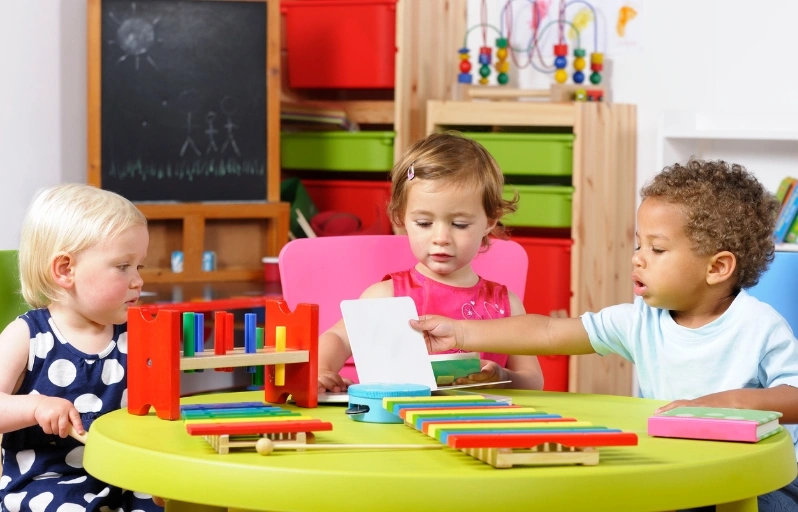Why Do Toddlers Say No?

Why Do Toddlers Say No? The Montessori Way to Handle Independence Battles
Every parent has been there: you ask your toddler to put on their shoes, and they look you straight in the eye and say, “No.”
It can be frustrating, especially when you’re rushing out the door. But according to the Montessori philosophy, that tiny “no” is actually something beautiful. It’s the first spark of independence, the beginning of your child discovering who they are.
At Joyous Montessori, we believe that behind every act of defiance lies a developing sense of self. Understanding this perspective can turn power struggles into powerful learning moments for both you and your child.

Why Toddlers Say “No”, The Montessori Perspective
Between the ages of 1 and 3, children go through an incredible phase of self-discovery. They begin to realize that they are separate individuals, with their own wants, feelings, and choices. This awareness is exciting for them, but challenging for parents.
In Montessori education, we call this the “Sensitive Period for Independence.” During this time, children are not trying to be difficult; they’re experimenting with autonomy. Saying “no” gives them a sense of control in a world where most decisions are made for them.
Rather than viewing “no” as rebellion, Montessori guides see it as a child’s way of saying, “I want to do it myself.”
The Power Struggle: Why It Happens
Imagine this: you’re in a hurry, and your toddler refuses to get dressed. You insist, they resist, emotions rise, tears flow, and everyone feels upset.
This tug-of-war is common, but Montessori teaches us that children thrive on mutual respect, not control.
Toddlers are naturally drawn to independence. When we rush or take on tasks, we feel powerless. Their “no” is often a cry for agency, not misbehavior.
At Joyous Montessori, we aim to give children freedom within limits, allowing them to explore independence safely while maintaining clear boundaries and loving guidance.

The Montessori Way to Handle Independence Battles
Here are a few Montessori-inspired strategies parents can use at home to handle toddler resistance gracefully:

1. Offer Limited Choices
Instead of commanding, “Put on your shoes,” try offering choices:
“Would you like to wear your red shoes or your blue shoes today?”
This approach respects your child’s autonomy while guiding them toward cooperation.
Montessori classrooms are built around this idea, children choose activities, decide where to sit, and learn responsibility through decision-making.

2. Slow Down the Routine
Rushing through daily tasks often triggers resistance. Toddlers move at their own rhythm, and Montessori environments honor that pace.
Try waking up a few minutes earlier or allowing extra time for transitions. When children feel unhurried, they’re more willing to cooperate.
At Joyous Montessori, our teachers create calm, predictable routines that make children feel secure and respected.

3. Encourage “Do It Myself” Moments

4. Model Calm and Respect
Toddlers mirror adult behavior. If you respond to “no” with frustration, they will too.
Take a deep breath, kneel to their level, and speak softly:
“I see you don’t want to do that right now. Let’s try together.”
Montessori teachers use gentle redirection instead of punishment, reinforcing trust and emotional safety.

5. Create a Prepared Environment
At home, design spaces where your child can move and make choices independently.
Keep their belongings at their height, clothes in low drawers, snacks in accessible containers, and a step stool near the sink.
When children can manage simple tasks on their own, they say “no” less often because they feel empowered.
When to Step In
Of course, not every “no” can be negotiated. Safety always comes first. Montessori emphasizes “freedom within limits”, allowing independence but setting clear, consistent boundaries.
For example:
“You can choose to walk or hold my hand, but you must stay close when we cross the road.”
Children respect limits when they understand why they exist and when those limits are delivered with empathy rather than control.


Turning “No” into Connection
When handled patiently, these moments of defiance can strengthen your bond with your child.
Every time you respond calmly, you’re teaching emotional regulation, mutual respect, and trust.
At Joyous Montessori, our approach helps children develop not just academically, but also emotionally and socially. We view each “no” as a stepping stone, a sign of growth, curiosity, and courage.
Over time, that confident toddler who once said “no” to wearing shoes becomes a thoughtful child who says “yes” to challenges, kindness, and learning.
